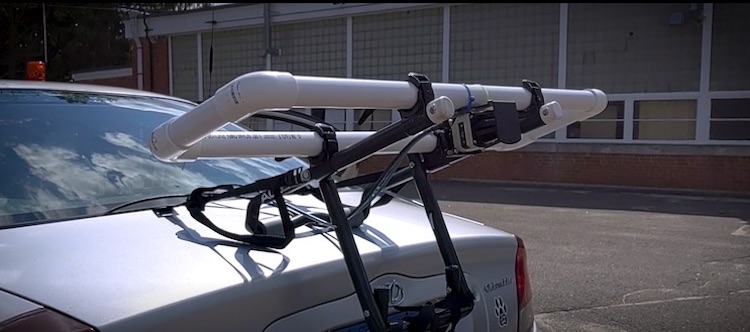
University students compete in SICK’s second annual TiM$10k Challenge
For the second consecutive year, sensor manufacturer SICK invited students from universities around the country to participate in the company’s TiM$10K Challenge.
The challenge started in 2018 to support innovation and student achievement in automation and technology.
Teams were supplied with a 270° SICK LiDAR sensor (TiM) and accessories and challenged to solve a problem, create a solution, or bring a new application to any industry that utilizes the SICK LiDAR.
The winners of the TiM$10K Challenge are:
- 1st Place: Worcester Polytechnic Institute Team 1 – Automating road conditions data collection (ROADGNAR)
- 2nd Place: University of Illinois at Urbana-Champaign – Preventing theft on construction sites (L-PUPP)
- 3rd Place: Rochester Institute of Technology – Extending single beam LiDAR to full resolution
- Honorable Mention: Michigan Technological University – Evaluating Road Markings (The Road Stripe Evaluator)
Daniel Pelaez, representative of Team 1 from Worcester Polytechnic Institute, the first place winner of the TiM$10K Challenge, says: “It was a wonderful learning experience getting to use such an awesome, high-quality sensor to actually solve a problem with a project that we had been working on for over a year before the challenge. It was an awesome experience.”
Project summaries
The first place team, Team 1 from Worcester Polytechnic Institute, created an innovative product called the ROADGNAR.
The ROADGNAR detects, analyzes, and measures potholes, cracks, and other things that cause roadways to be in poor condition. With this data, local governments can better prioritize what roads need to be repaired first based on the condition.
The second place team, University of Illinois at Urbana-Champaign, developed the L-PUPP, a device intended to detect when a theft is occurring at a construction site.
The L-PUPP, or LiDAR Portable Ultimate Protection Product, can be installed all around a construction site to detect any unauthorized breaches onto the site.
The third place team from Rochester Institute of Technology created a solution that uses a 2D LiDAR sensor and a camera to extend single beam LiDAR to full resolution.
With this solution, companies using automated mobile robots can use a less cost prohibitive solution that also provides a comparatively higher resolution at a much faster rate, with the ability to determine per-pixel depth.
Finally, the team from Michigan Technological University received an honorable mention for their innovative product that aims to help resolve issues caused by poor road markings while also reducing maintenance costs and improving motorist safety.
Tony Peet, CEO of SICK, said: “There’s an opportunity for a business to get started from any of these projects. These are high-quality products with great market value that all provide improvements to the industry.
“We’re extremely proud of all the students who participated.”
Contest background
Each team was asked to submit a video and paper for judging upon completion of the project. A panel of judges decided the winning submissions based on creativity and innovation, ability to solve a customer problem, commercial potential to productize and market the application, entrepreneurship of the team, and reporting.
The three winning teams win a cash award of $10K for first place, $5K for second place, and $3K for third place.
In addition to bragging rights and the cash prize, the first place team, along with the advising professor, will go on an all-expense paid trip to Germany to visit the SICK headquarters and manufacturing facility.
This contest was supported by PMMI Foundation’s U Skills Fund. PMMI Foundation works to grow awareness of careers in packaging and processing, providing assistance to schools and programs that develop students to excel in the industry.
LiDAR sensor technology
The LiDAR sensor (TiM) provided to teams utilizes a rotating pulsed laser to calculate distances to its surroundings based on the time-of-flight principle.
The rotating laser effectively forms a circle around the TiM, inside which users can create individual fields to monitor for the presence or absence of an object.
The reliability of the sensor is improved by SICK’s patented High-Definition Distance Measurement (HDDM) technology, which samples each measurement several times and averages the results.
As the TiM$10K teams ably proved, monitoring the individual fields for objects can be a great way to solve applications that other sensing technologies cannot.
This makes the TiM invaluable in a variety of industrial applications, as well as building automation, stationary, and mobile applications.
In addition, the integrated Ethernet interface allows for remote monitoring, measurement, and navigation which presented a ton of creative possibilities for the TiM$10K teams.
Register for the 2020-2021 TiM$10K Challenge
SICK is now accepting entries for the TiM$10K Challenge for the 2020-2021 school year. Student teams can register online by September 2, 2020.
Student teams are encouraged to use their creativity and technical knowledge to incorporate the SICK LiDAR for any industry in any application. Advisors/professors are allowed to guide the student teams as required.
For more details, visit: https://www.sick.com/us/en/tim10k/w/tim10k/
